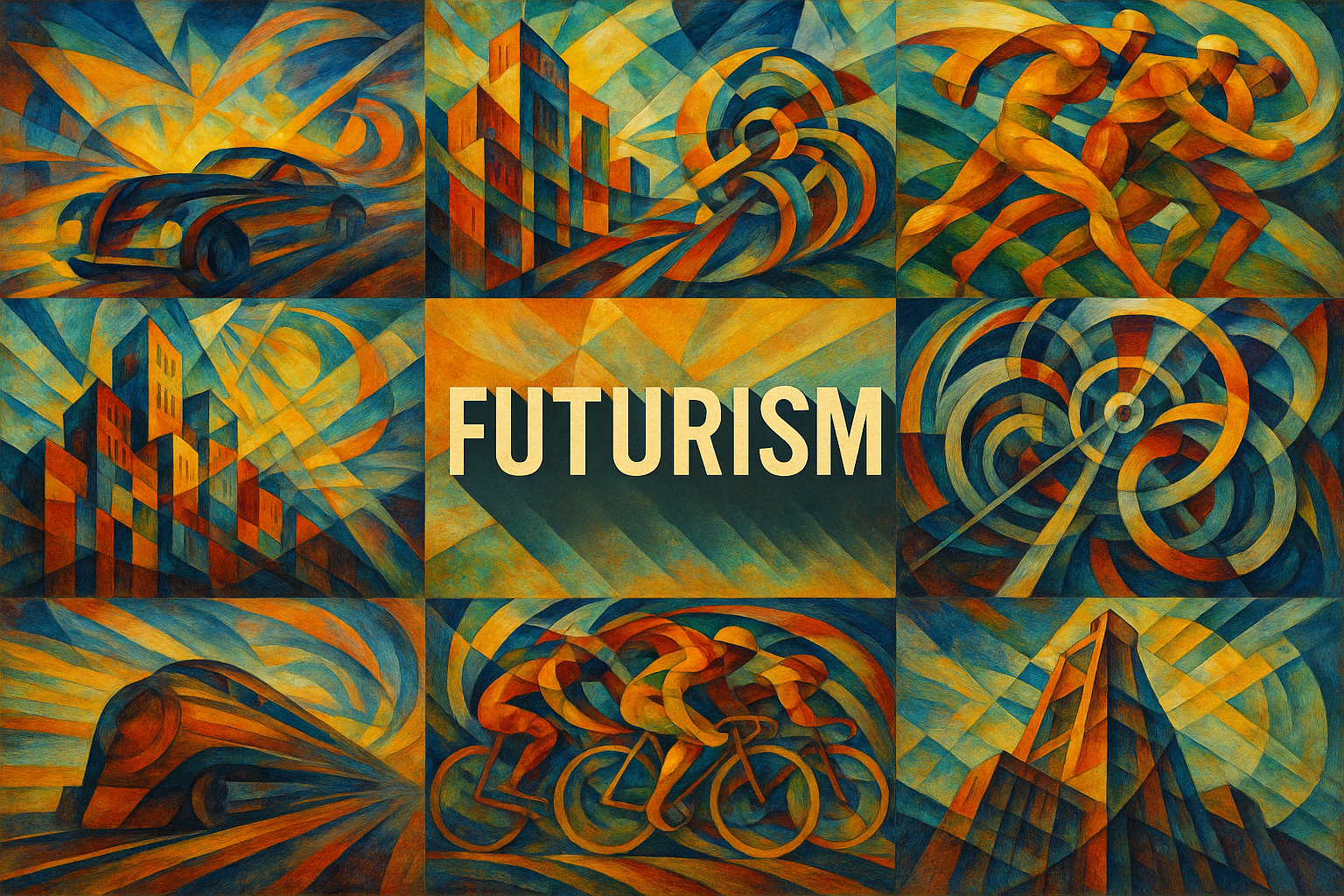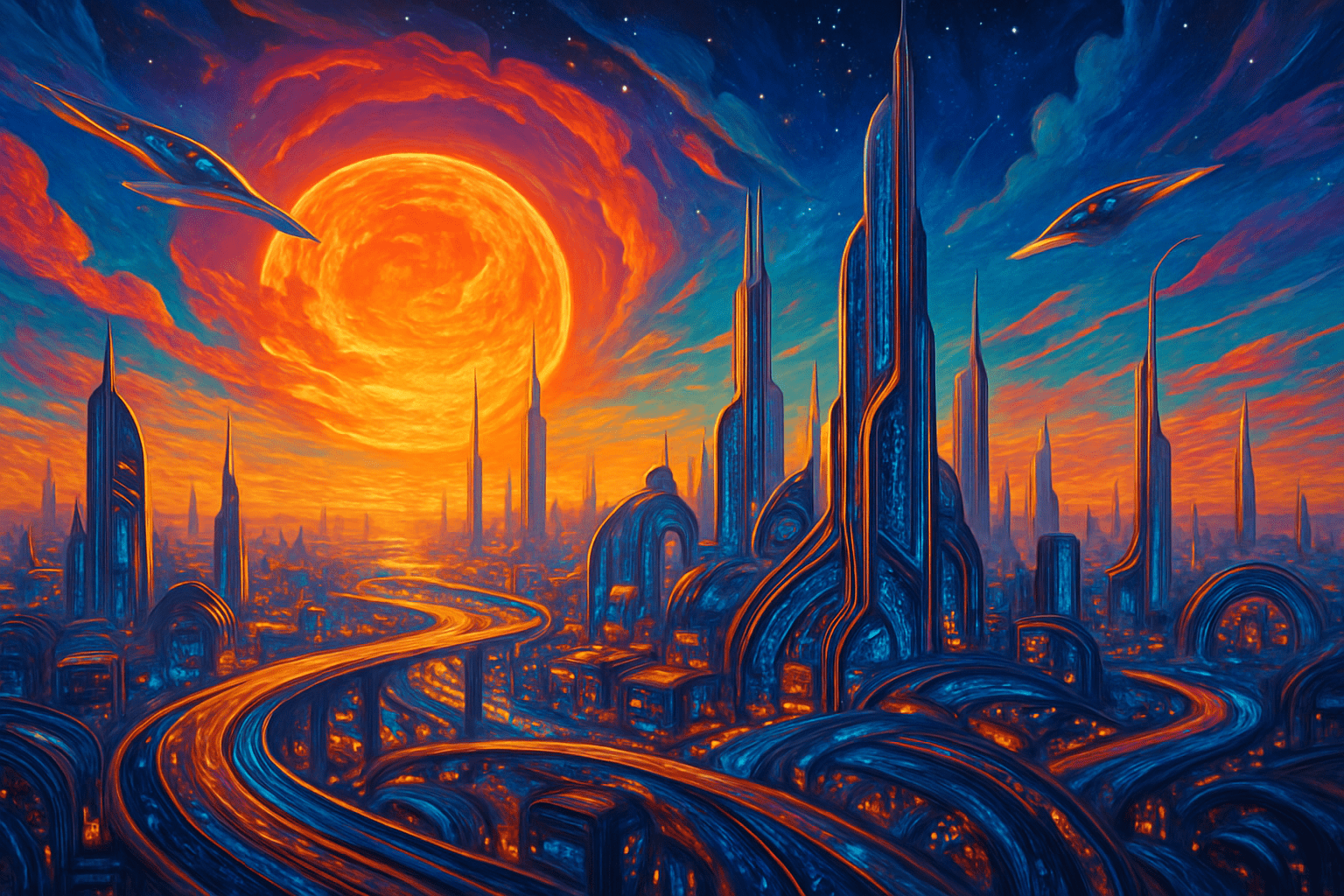
Futurism
The art style Futurism is characterized by its use of strong, bold colors and geometric shapes. It is often described as being “futuristic” or “modern” in appearance.
AOI thinking about Futurism [+_~]-/
Overview and Quickfacts
Futurism was an art movement that began in the early 20th century. It was characterized by its use of dynamic, often violent images to depict the energy and power of modern industrial society. Futurist artists sought to capture the speed and energy of the machine age, often using new technologies such as the automobile and the airplane as subjects for their work.
Can understand it also, as:
1. Modernism 2. Postmodernism 3. Cubism 4. Dadaism 5. Surrealism 6. Abstract Expressionism 7. Pop Art 8. Op Art
Categorize it as:
Impressionism, Modernism
.: Dreaming :.
holds a HAIKU for the art style
:. Thought is power .:
Detailed Description
Futurism was an art movement that began in the early 20th century. It was characterized by its use of dynamic and often violent imagery, and its rejection of traditional values. Futurist artists sought to capture the energy and power of modern industrial society. They celebrated speed, technology, and violence, and their work often reflected the chaotic nature of the modern world. Futurism was founded in 1909 by the Italian poet and critic Filippo Tommaso Marinetti. In his Futurist Manifesto, Marinetti called for an art that would be ÃÂÃÂaggressive, defiant, and triumphant.ÃÂÃÂ He and other Futurist artists believed that art should be a force for change, and they sought to use their work to promote their political and social ideas. Futurism was initially a purely Italian movement, but it soon spread to other countries, including France, Russia, and the United States. Futurist artists made use of a variety of media, including painting, sculpture, film, and poetry. They also experimented with new techniques and technologies, such as photomontage and collage. Some of the most famous Futurist artists include Giacomo Balla, Umberto Boccioni, and Carlo CarrÃÂÃÂ . BallaÃÂÃÂs painting Dynamism of a Dog on a Leash (1912) is a good example of the Futurist style, with its use of dynamic lines and sharp angles. BoccioniÃÂÃÂs sculpture Unique Forms of Continuity in Space (1913) is another well-known work of Futurist art. The Futurist movement had a significant impact on the development of modern art, and its ideas and techniques can be seen in the work of many later artists.
.. beep, beep, beep ..
<START OF TRANSMISSION>
1. Futurism was an artistic and social movement that originated in Italy in the early 20th century. 2. The Futurists were interested in dynamism, speed, energy, technology, and violence. 3. They believed that the modern world was constantly changing and that this change was something to be celebrated. 4. The Futurists were particularly interested in the potential of new technologies, such as automobiles and airplanes. 5. They believed that art should reflect the dynamism of the modern world. 6. The Futurist Manifesto, published in 1909, called for an end to traditional art forms and for a new art that would be in harmony with the modern world. 7. The Futurists were opposed to traditionalism and conservatism. 8. They believed in progress and were optimistic about the future. 9. The Futurists were controversial in their time and their ideas were often met with hostility. 10. Many of the FuturistsÃÂÃÂ ideas, such as their celebration of speed and technology, have become part of mainstream culture. 11. The Futurists had a significant influence on the development of modern art, particularly in the areas of painting and sculpture. 12. They were also influential in the fields of architecture, literature, and music. 13. Futurism was one of the first truly international movements in the arts. 14. The Futurists were active in many different countries and their ideas were disseminated widely. 15. The movement began to decline in the 1920s, but its legacy continues to be felt in the arts. 16. Futurism was an important precursor to the development of abstract art. 17. It also had a significant influence on the development of Surrealism. 18. Many of the leading Futurists were eventually co-opted by the Fascists and their ideas were used to support the regime. 19. Futurism is often seen as a precursor to the more recent movements of Postmodernism and Neo-Futurism. 20. The term ÃÂÃÂfuturismÃÂÃÂ is now used more broadly to refer to any art that celebrates change and progress.
<EOF>
.. robbel bob
Visual Examples from our image gallery
Coming soon, we are so slow .. might never come
Artists, Paintings, and more
(be aware, can be highly speculative)
Artists (be aware, speculation possible):
1. Umberto Boccioni (1882-1916) 2. Carlo CarrÃÂÃÂ (1881-1966) 3. Luigi Russolo (1885-1947) 4. Giacomo Balla (1871-1958) 5. Gino Severini (1883-1966) 6. Fortunato Depero (1892-1960) 7. Mario Sironi (1885-1961) 8. Ardengo Soffici (1879-1964) 9. Filippo Tommaso Marinetti (1876-1944) 10. Anton Giulio Bragaglia (1890-1960) 11. Bruno Munari (1907-1998) 12. Enrico Prampolini (1894-1956) 13. Fillia (1899-1927) 14. Lucio Fontana (1899-1968) 15. Dadamaino (1930-2004) 16. Getulio Alviani (1929-2013) 17. Giovanni Anceschi (1933-1985) 18. Grazia Varisco (1937-2009) 19. Luciano Fabro (1936-2007) 20. Piero Manzoni (1933-1963) 21. Agostino Bonalumi (1935-2013) 22. Enzo Cucchi (1949-present) 23. Francesco Clemente (1952-present) 24. Mimmo Paladino (1948-present) 25. Nicola De Maria (1954-present) 26. Sandro Chia (1946-present) 27. Salvatore Mangione (1958-present) 28. Stefano Tordiglione (1962-present) 29. Vittorio Messina (1964-present) 30. Walter De Maria (1935-2013)
Artworks (be aware, speculation possible)
1. “The City Rises” (1910) by Umberto Boccioni 2. “Unique Forms of Continuity in Space” (1913) by Umberto Boccioni 3. “The Street Enters the House” (1911) by Carlo CarrÃÂ 4. “The Funeral of the Anarchist Galli” (1911) by Carlo CarrÃÂ 5. “The Singing Lesson” (1913) by Carlo CarrÃÂ 6. “The Red House” (1911) by Luigi Russolo 7. “The Noise” (1913) by Luigi Russolo 8. “The City of the future” (1914) by Antonio Sant’Elia 9. “The Dancers” (1915) by Giacomo Balla 10. ” Dynamism of a Dog on a Leash” (1912) by Giacomo Balla 11. “The Hand of the Violinist” (1912) by Giacomo Balla 12. “Speed + Sound” (1913) by Giacomo Balla 13. “Futurist Painting: Technical Manifesto” (1914) by Giacomo Balla 14. “Futurist Painting: Dynamic Hieroglyphic of the Bal Tabarin” (1912) by Giacomo Balla 15. “Futurist Painting: Spatial Force Constructions” (1913) by Giacomo Balla 16. “Futurist Painting: Light-Space-Time” (1913) by Giacomo Balla 17. “Futurist Painting: The Fourth Dimension” (1913) by Giacomo Balla 18. “Futurist Painting: Simultaneity – Multiple Perspective” (1913) by Giacomo Balla 19. “Futurist Painting: Airplane in Flight” (1913) by Giacomo Balla 20. “Futurist Painting: The War” (1915) by Giacomo Balla 21. “Futurist Painting: Swifts Flying Over Rome” (1913) by Giacomo Balla 22. “Futurist Painting: The Speed of Light” (1913) by Giacomo Balla 23. “Futurist Painting: The Race on Montecarlo” (1914) by Giacomo Balla 24. “Futurist Painting: The Street Light” (1914) by Giacomo Balla 25. “Futurist Painting: The Laugh” (1914) by Giacomo Balla 26. “Futurist Painting: The City on the Sea” (1914) by Giacomo Balla 27. “Futurist Painting: The Dancer” (1915) by Giacomo Balla 28. “Futurist Painting: The Violinist” (1915) by Giacomo Balla 29. “Futurist Painting: The Flying Machine” (1915) by Giacomo Balla 30. “Futurist Painting: The Airplane” (1915) by Giacomo Balla
Epoch
The time period of the art style Futurism is from 1909 to 1914.
AI ART RESSOURCES (AKA, well Tools)
Helping tools -> predefined search links on other pages:











